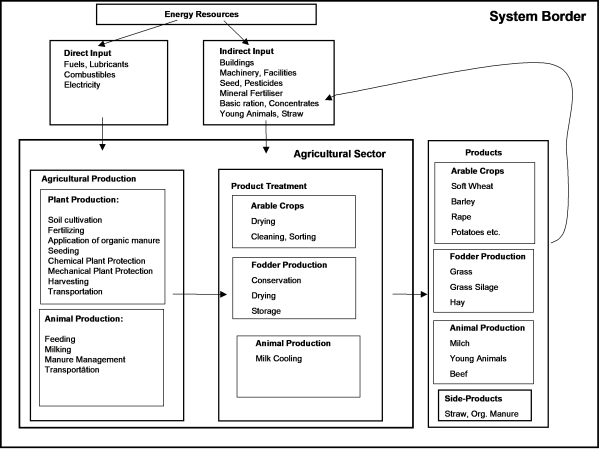This is an old revision of the document!
Table of Contents
Energy Use in Agriculture
Introduction and basics
The objective of the CAPRI energy indicator is to improve the existing CAPRI model in its capabilities to display environmental effects of agricultural production activities. In order to give a short overview of the structure of the energy indicator, the underlying methodology of Life Cycle Analysis will be introduced covering structure of the energy coefficients used for assessment. In a second part, the assessment methodology of the single direct and indirect components will be described. Finally, the structure of the results being processed by the energy module will be shown and hints for application will be given. Energy input quantification follows process analysis within the methodology description of Cumulative Energy Demand (KEA) guideline N° 4600 (VDI, 1997). Thereby, the KEA states the entire demand of non-renewable energy resources, valued as primary energy, which arises in connection with the production, use and disposal of an economic good (product or service) or which may be attributed respectively to it in a causal relation (VDI, 1997). A precise definition of balancing boundary setting is carried out according to local, temporal and technological criteria and is an important foundation for the KEA. Due to the high complexity and multiplicity of some of the interactions between individual processes, systematic delimitation frequently poses a central problem for energy analysis. A detailed determination of all relevant energy and material flows in the service life of a product requires a separation of the components of the KEA right down to the individual processes. An energy balance in this context registers energy quantities or energy types respectively in Joule or Watt-hours, crossing the defined balance space boundaries during the period of analysis. The energy balance boundaries are identical with the material balance boundaries (VDI, 1997). In the CAPRI context, the input part of the KEA concept is underlying the energy assessment of agricultural production. Life cycle analysis (LCA), by integrating the KEA concept offers a suitable framework for energy assessment of CAPRI production activities. Therefore, guidelines such as ISO 14040 and 14044 (DIN, 2006) are considered in the energy assessment process. Such procedure is based on process analysis, which can be defined as follows: “The network or processes required to make a final product are identified. Each input is assigned an energy requirement so that the total energy requirement can be summed” (Fluck, 1980). Setting the system borders precisely is an essential task in this concern. Figure 40 shows the relevant borders and integrated processes for CAPRI energy module. The term “Agricultural Production” in Figure 40 is the main interface between LCA and CAPRI production activities.
Figure 40: System border and processes considered for CAPRI energy input assessment

Source: Based on ecoinvent (2003)
The connecting link between process-based material flows and the energy requirement analysis are energy content factors. Life cycle inventories of agricultural production systems are the necessary tool therefore. The role of inventories such as ecoinvent (2003) is to provide modules for infrastructure and inputs used in agricultural production necessary for modelling production systems. In the case of the CAPRI energy module, several aspects concerning inventories had to be considered. On the one hand, a broad range of different sources provide inventory databases designed for different countries in the agricultural context. On the other hand, to use a uniform methodological basis, a basic decision for inventories analysed by ecoinvent (2003) was taken. Firstly, a great number of single inventories (direct and indirect energy sources as well as agricultural processes such as drying or irrigation) had been analysed. Secondly, the inventories being used are updated regularly and by using SALCA061 (2006) database for CAPRI energy indicator, a most recent version of the inventories was used. Thirdly, special analysis for the CAPRI energy module such as quantifying energy for stables for animal production activities was carried out using the underlying methodology of ecoinvent database in order to consider specifics of CAPRI. Nevertheless, the ecoinvent agricultural inventories have been compiled mainly in a Swiss context using background data of Swiss agriculture. In order to use these inventories for CAPRI, some adjustments have been made. Some minor differences in the energy assessment between CAPRI energy module and other literature sources cannot be avoided. The reason might be in the reference period of the data (most literature data is of some years age) or in the Swiss-based approach of the inventories.
Energy assessment in CAPRI
To integrate the methodology which is described in Chapter 7.3.1 
Direct energy sources
Direct energy covers those energy sources that are consumed directly in the production process for the purpose of generation of usable energy (Werschnitzky et al. 1987). For diesel fuel, petrol, heating oil, electricity, gas, coal etc., the input quantities of each animal and plant production activity are calculated and afterwards assessed by energy content factors. The content factors are based on ecoinvent modules using SALCA061 database (2006). Table 30 shows the main direct energy sources used in CAPRI.
Table 30: Energy content factors for direct energy input
| Direct energy component | Cumulative energy demand | Unit |
|---|---|---|
| Diesel | 45.7 | MJ/l |
| Electricity (at grid) | 11.7 | MJ/kWh |
| Heating Gas (in industrial furnace) | 47.9 | MJ/m3 |
| Heating Oil (in industrial furnace) | 49.7 | MJ/l |
